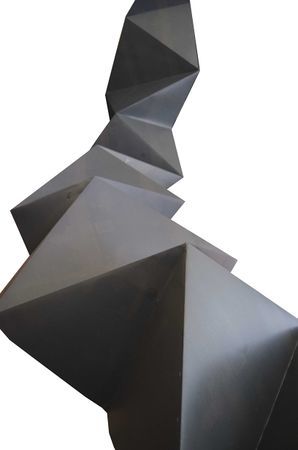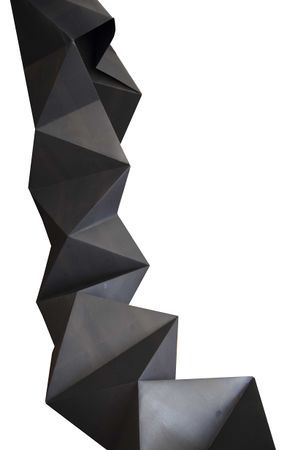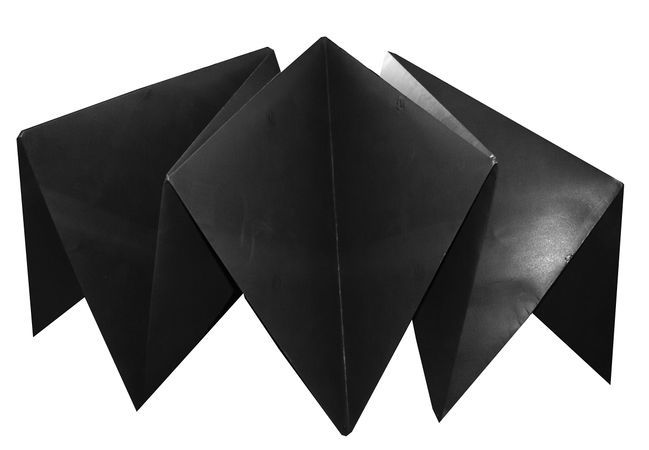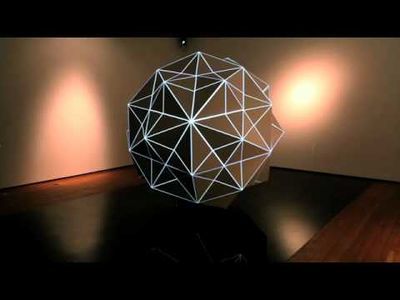MW




Breathe with me
We all know it, everyday life with its ups and downs, the stress, setbacks, always wishing time would slow down and praying for that holiday to come soon. Failure becomes shame and success becomes standard. The restrictions and pressure we put upon ourselves result in less inspiration and happiness.
Sama Vritti is a breathing exercise that helps the body reduce stress hormones and helps the mind focus. The origami structure that moves up and down creates a breathing rhythm according to the Sama Vittri breathing technique. The patterns reflected on the origami come together with the in- and exhaling of the viewer. The viewer will unconsciously interact with the piece and perform a Sama Vritti breathing exercise and thus relax and become more focused.
Sama Vritti or “Equal Breathing” Sama Vritti is a Sanskrit phrase, 'sama' meaning 'even, smooth, flat, equal or same' and 'vritti' means 'fluctuations or modifications'. So the phrase indicates a smoothing of the fluctuations of the mind into stillness. As its name suggests, it is said to create quality of 'sameness' or balance in the flow of consciousness.
Sama Vritti is one of the techniques used in the practice of pranayama or yoga breathing exercises. Pranayama is one of the Eight Limbs of classical yoga according to Patanjali, a great Indian sage. Pranayama is practiced by those who are interested in yoga asanas or postures for well-being and also spiritual enlightenment.
Choosing to take deep, regular breaths is a way to calm your autonomic nervous system, naturally reducing stress hormones in the body. It also helps focus your mind and can be used in meditation practice. And it's easy to do! Even kids can learn how do do a practice like sama vritti, which can be done almost anywhere and reduces stress and anxiety quite quickly. Learn this pranayama and then add it to your arsenal of calming techniques.
Sama-vritti is an equal ratio breathing technique practiced by making sure that the inhalation is the same length as the exhalation. This may be facilitated by a mental count to ensure the evenness is maintained. Instructions: 1. Come to sit in a comfortable, cross-legged position such as easy pose, taking padding under your seat as necessary. If sitting on the floor isn't possible, lie on your back or sit in a chair. 2. Close your eyes and begin to notice your natural breath, not changing anything at first. Give yourself a good five breaths or so. 3. Begin to slowly count to four as you inhale. Take a moment at the top of your inhale with the lungs full of air. Then also count to four as you exhale. Again take a moment to feel empty. Then inhale again to another count of four. Continue this pattern. The exercise is to match the lengths of your inhales and exhales. 4. You may experiment with changing the number you count to, just make sure your inhale and exhale stay the same length. 5. Continue breathing this way for several minutes. Option1: Reduce the exhale to match the inhale: inhale = 6 counts exhale = 6 counts Option 2: Add both numbers: inhale+ exhale – 6+8=14 and divide by 2 14/2=7 Hence your counts will be: inhale = 7 exhale = 7 However if your two counts add up to an odd number such as: inhale = 5 exhale = 6 inhale+ exhale 5+6=13 then decrease by one number 13-1=12 then divide by 2 = 6 Hence your counts will be: inhale = 6 exhale = 6
Sources:
1. https://www.verywell.com/sama-vritti-equal-breathing-3566764 2. http://www.yogajournal.com/article/practice-section/adding-pranayama-and-meditation-to-your-yoga-practice/ 3. http://hubpages.com/health/What-is-Sama-Vritti-Equal-Breathing 4. Rosen, Richard, The Yoga of Breath – A Step-by-Step Guide to Pranayama. Shambhala Publications Inc, Boston, 2002. 5. Smith C, Hancock H, Blake-Mortimer J, Eckert K. "A randomised comparative trial of yoga and relaxation to reduce stress and anxiety." Complement Ther Med. 2007 Jun;15(2):77-83. Epub 2006 Jun 21. 6. Cyndi Lee is the founder of OM yoga center in New York City. She is a longtime practitioner of Tibetan Buddhism and has been teaching yoga for over 20 years. Cyndi is the author of OM yoga: A Guide to Daily Practice(Chronicle Books) and the upcoming Yoga Body, Buddha Mind (Riverhead Books). For more information, visitwww.omyoga.com 7.
I have created long strokes of origami pieces. My goal is to make the origami move with the viewer. I looked into PIR sensors, they can detect movement and create a response according to the movement. But I realised that first of all I need to know the shape so I know where the sensors should be placed and what they need to do. As a result I want a origami piece that feels like it is alive, and thus mesmerizes people. A possible addition to the plan could be projection mapping on the origami, I have tried if the origami is suitable for that and it responded very well.











